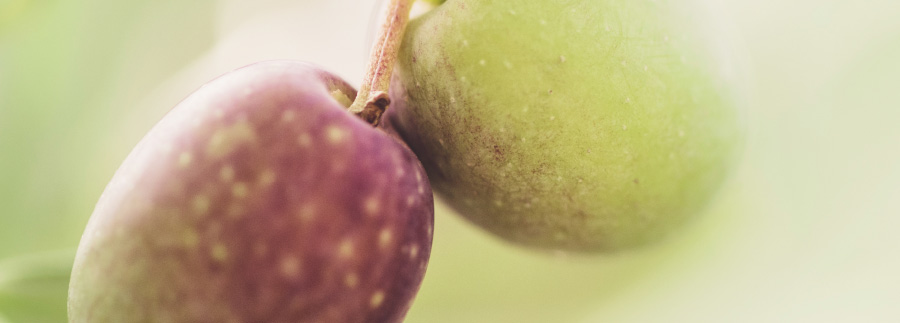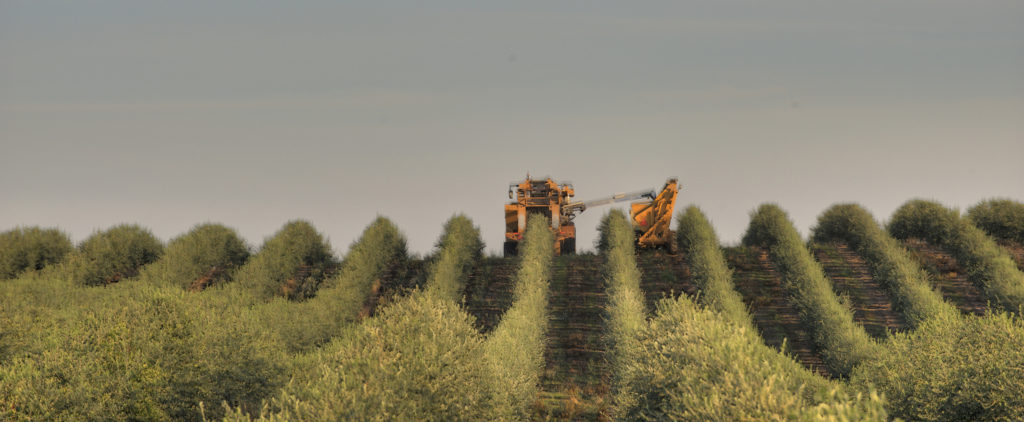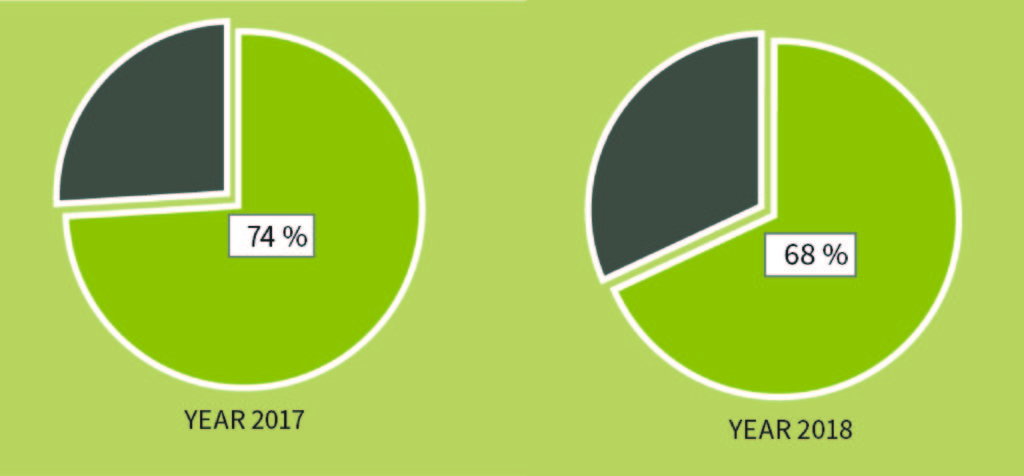Strict Quality Standards
The OOCC refers to our standard for California Extra Virgin Olive Oil required under the California Department of Food and Agriculture as one of the most stringent in the world for good reason. The CA Extra Virgin Olive Oil standard includes all the tests and parameters for olive oil purity found in the California Health and Safety Code. It also contains more stringent parameters for quality tests and incorporates the valuable tests for DAGs and PPP. Below is a chart comparing the CA Extra Virgin Olive standard to those under the United States Department of Agriculture and International Olive Council.
Extra Virgin Olive Oil Standard at a Glance

| USDA* and IOC | CDFA* | ||
|---|---|---|---|
| Free fatty acid (%m/m) | ≤ 0.8 | ≤ 0.5 | |
| Peroxide value (meq O2/kg oil) | ≤ 20 | ≤ 15 | |
| Absorbency in ultraviolet K232 | ≤ 2.50 | ≤ 2.40 | |
| Absorbency in ultraviolet K270 | ≤ 0.22 | ≤ 0.22 | |
| Absorbency in ultraviolet ΔK | ≤ /0.01/ | ≤ /0.01/ | |
| Moisture and volatile matter (%m/m) | ≤ 0.2 | ≤ 0.2 | |
| Insoluble impurities (%m/m) | ≤ 0.1 | ≤ 0.1 | |
| Pyropheophytin a (PPP) (%) | – | ≤ 17 | |
| 1, 2 Diacylglycerols (DAGs) (%) | – | ≥ 35 | |
| Organoleptic analysis (Sensory) — Median defects Median fruity |
MeD = 0 MeF = 0 |
MeD = 0 MeF = 0 |
About the Parameters
Free fatty acid or free acidity (FFA)
A measurement of the breakdown of the fats. It gives some indication of oil quality based on fruit quality and handling. Although FFA does not change much over the life of oil, a lower FFA level at production will contribute to longer shelf life.
Peroxide value (PV)
A measure of peroxide compounds arising from primary oxidation. A high peroxide value usually indicates poor processing, and that the oil might not keep well. The final stage in oxidation is peroxide breakage, resulting in the formation of new compounds that we can perceive as rancid smelling.
Ultra violet absorbency (UV)
An indicator of oxidation using the UV spectrum at different wavelengths. K232 is considered a critical marker for good quality extra virgin olive oil. Oxidation is the result of natural aging or indicative of poor handling or heating during the refining process.
Pyropheophytins (PPP)
Breakdown products of chlorophyll. Over time, chlorophyll breaks down first into pheophytins then into PPP, making PPP an excellent indicator of the age of an oil. Light and heat can accelerate the production of PPP.
1,2- and 1,3-diacylglycerol (DAGs)
Breakdown products of the fats. 1,2-DAG is high in well-made fresh olive oil from good fruit and 1,3-DAG is higher in olive oil made from poor quality fruit or oxidized or refined olive oils. The ratio between 1,2-DAGs and 1,3-DAGs declines steadily and is a good indicator of the age of an oil.
Organoleptic (sensory)
Analysis by a trained taste panel using official protocols is an important part of determining the grade of virgin olive oil. Taste panels identify and quantify defects and basic positive attributes in an olive oil. To be classified as extra virgin, an olive oil may have no defects in flavor, and must have fruitiness.

The Complete Picture
Chemical analysis and sensory analysis are both required for a complete assessment of the quality of olive oil; they are complementary procedures. Chemical analysis provides valuable information about the current condition of an oil, but there is no single test that can definitively determine quality. For example, the strong relationships between DAGs, PPP and sensory intensity can be used to predict, track and monitor the quality of extra virgin olive oils over time.
Download the PDF here.
Modern Farming and Harvest Techniques
California’s Mediterranean climate has the ideal conditions for growing olives for olive oil. Marrying modern farming and harvest techniques with the generations-old tradition of flavorful olive oil, the goal of California olive oil farmers of today is producing the freshest Extra Virgin Olive Oil possible.
True Extra Virgin olive oil is simply fresh-pressed juice from olives picked when they are just changing from green to violet on the tree. Modern harvesting techniques were developed by taking into consideration that the optimal time to harvest California olives for olive oil is in October and November. It’s at this time the olives produce the freshest oil possible. However, at this peak of freshness, the olive stems are still too strong to release the olives easily, requiring a creative approach to removing the olives during this stage.
Traditional olive oil harvesting relied heavily on manual labor, which is time consuming and often results in a finished product made from olives that have been on the tree too long. In California, olive trees are planted in a vineyard style, or “high density” system. This method of planting allows for the olives to be harvested from the trees using highly-specialized over-the-row harvesters, which have gentle picking fingers. Using these mechanical harvesters, the California olive oil crop can be harvested quickly while olives are at their freshest and best quality. This modern growing and harvesting system is what allows California to produce some of the freshest, highest quality olive oil the world.

What to Know When Purchasing California Olive Oil
Consumers looking for high quality olive oil should simply look for information on the label indicating the product is grown and bottled in California.
All major commercial producers of California olive oil are required to participate in a mandatory government sampling and testing program to verify quality under the OOCC. Members of the OOCC represent 90 percent of the olive oils produced in California. So, most of the California olive oil found in your grocery store is from an OOCC member. To be sure, you can find a list of OOCC members companies here.
The OOCC is devoting resources to ensure California olive oil found on store shelves is always of the highest quality. The OOCC recently funded a two-year research project conducted by the UC Davis Olive Center to determine the quality of California olive oils currently available at various California retail outlets. The study found the majority of California Extra Virgin olive oil is still meeting California’s strict standards one year after it was harvested and that efforts of the OOCC to improve quality appear to be working. You can read the full report on this study here.
 Seventy-four percent of the samples of California olive oils collected in 2017 and 68% of samples collected in 2018 from various retail outlets meet the California Extra Virgin Olive Oil Standard.
Seventy-four percent of the samples of California olive oils collected in 2017 and 68% of samples collected in 2018 from various retail outlets meet the California Extra Virgin Olive Oil Standard.
This study is part of an ongoing effort to improve the quality of California olive oils. Many factors impact olive oil quality from bottling through distribution channels to retail store shelves, but it all starts with the quality of the olive oils at harvest. The studies’ findings present an opportunity to provide actionable information to help producers improve and maintain the quality of their olive oil.
Attention: Retailers
The Olive Oil Commission of California and the California Olive Oil Council invite you to view this webinar designed specifically for U.S. retailers interested in expanding sales of high quality olive oil.